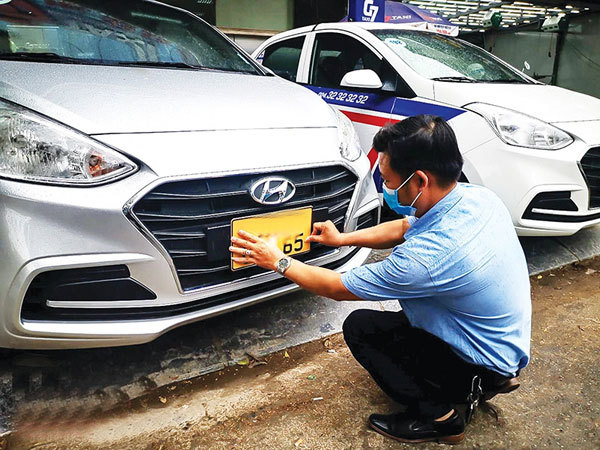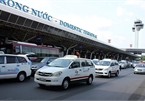 |
| The new yellow licence plates are meant to distinguish commercial vehicles from privately-owned ones, Photo Le Toan |
According to the Ministry of Public Security’s (MoPS) Circular 58/2020/TT-BCA released in June, all vehicles used for commercial purposes in Vietnam will need to change their licence plates from black-on-white to black-on-yellow. The circular officially came into effect on August 1, and all licence plates must be changed by the end of the year.
Data from the MoPS’ Traffic Police Department estimates that around 1.6 million four-wheeled vehicles registered for commercial transportation are subject to this new regulation. It means all cars, trucks, buses, and ride-hailing vehicles used for commercial purposes also need to implement the change.
However, there are several obstacles during the transition process. Nguyen Xuan Tuan, head of a transportation co-operative managing more than 20,000 ride-hailing vehicles, said they are bewildered about the policy.
“According to the Ministry of Finance, it costs VND150,000 (nearly $7) to change one licence plate. It means we will have to spend VND3 billion ($130,000) for the process, which will disrupt our operations and drivers’ income,” he noted.
In addition, individuals and businesses will have to spend more time and financial resources meeting this provision, which could lead to rising fares which directly affects consumers.
Nguyen Van Nam, a ride-hailing driver with two years of experience, said that the change will not only affect their livelihoods but also reduce a car’s value when sold, along with many other consequences.
In Vietnam, the transport sector has been steadily modernising its vehicles. Most commercial cars are equipped with electronic clocks as well as contract vehicle badges and business registration. Thus, it is not necessary to change the licence plates, according to Nam.
However, lieutenant colonel Pham Viet Cong from the Traffic Police Department argued that the identification of vehicle colours is important to solve problems in the management of business vehicles. He said that in his eyes the “fee for changing the plate is not high – people only have to pay the fee as prescribed which is a just over VND100,000 ($4.30) for the exchange.”
Commenting on the new policy, Nguyen Viet Linh, PR director of Vietnamese ride-hailing firm Be Group, told VIR its drivers will have to contact the authorities to change the plate colour in accordance with the law. The firm will help the drivers better understand Circular 58. At present, the firm’s business remains stable after the economic impact of the pandemic, so drivers are expected to comply with the implementation of the new policy to continue working. Currently, the firm’s ride-hailing department is still reviewing different options to provide assistance for its drivers.
Similarly, a representative of Grab Vietnam said that the company is working with the local authorities and co-operatives to provide specific and detailed instructions for GrabCar drivers to ensure full compliance with Circular 58.
Unlike ride-hailing firms, large taxi companies in Vietnam with fleets of thousands of vehicles will face rising expenses from the new policy. Mai Linh Group, one of the largest taxi companies in the country, said that it will be responsible for its directly-owned fleet while individual taxi drivers will pay for themselves.
Despite the extra expenses, Ho Huy, chairman of Mai Linh welcomed the policy since it will create an obvious distinction between private cars and commercial vehicles, thereby creating a fair and equal playground for transport businesses.
“In the long term, the government can also more effectively collect tax from individuals and enterprises engaged in transport businesses,” Huy said. “Thus, Mai Linh is eager to change the colour of its plates in line with the new policy. We hope that the government can ease the administrative procedures and apply more reasonable fees for transport businesses.”
On the same note, deputy general director of Vinasun Ta Long Hy said that taxi firms have been in tough financial times after suspension during the social distancing measures. However, Vinasun is eager to invest money to change the plate colour of its vehicles because it will help the government identify commercial and non-commercial vehicles, according to Hy.
The latest policy is one of Vietnam’s efforts to regulate transport businesses in a new competitive landscape where ride-hailing firms are eating up the market share of traditional taxis. Over the last few years, there has been a fierce battle between traditional taxi companies and ride-hailing platforms.
Julien Brun, managing partner of CEL Consulting, said that the battle highlights the challenge behind disruptive businesses that are using technology and follow a completely new economic model which does not typically fit into the legislative framework.
“Whether the framework should evolve or companies should try to fit in remains open,” he said. “This new competition also requires taxi companies to innovate themselves to remain attractive and competitive, which can be seen as a benefit. However, fair competition also requires clear rules. The issue is whether these companies are comparable and whether they should follow the same rules.” VIR

Vehicles providing transport services will have yellow licence plates
All vehicles providing cargo and passenger transportation services must change from white licence plates to yellow ones with black letters and numbers from August 1, according to the Traffic Police Department under the Ministry of Public Security.

Transport service operators begin installing yellow number plates from today
Vehicles that have registered for transport services have started installing yellow number plates with black letters and numbers from today, August 1, instead of the current white plates.
 While recovering from the disruption caused by the pandemic, transport businesses in Vietnam will have to invest even more time and money to change the colour of their licence plates in line with the latest policies.
While recovering from the disruption caused by the pandemic, transport businesses in Vietnam will have to invest even more time and money to change the colour of their licence plates in line with the latest policies.